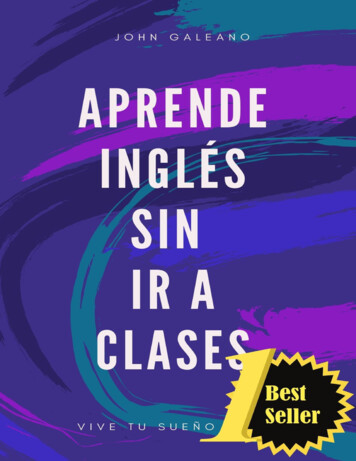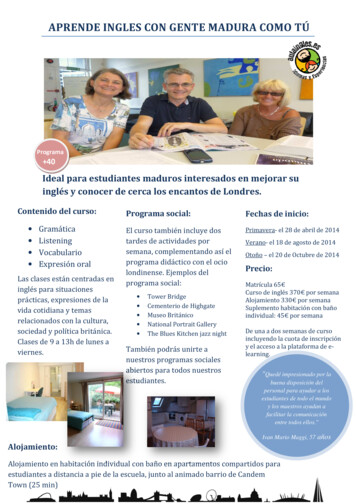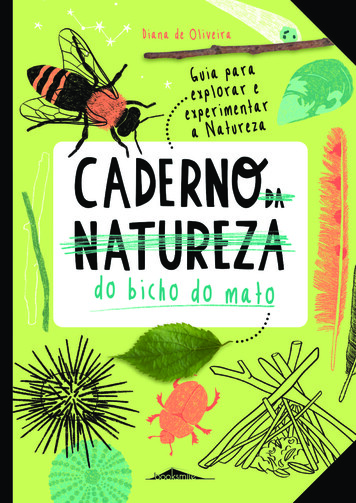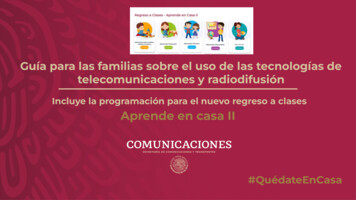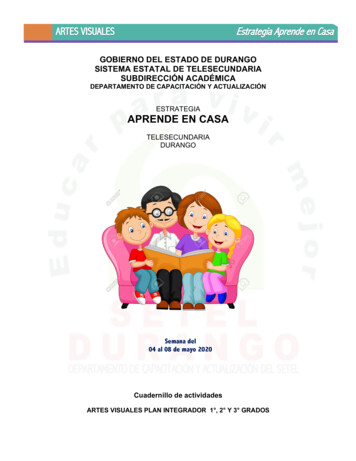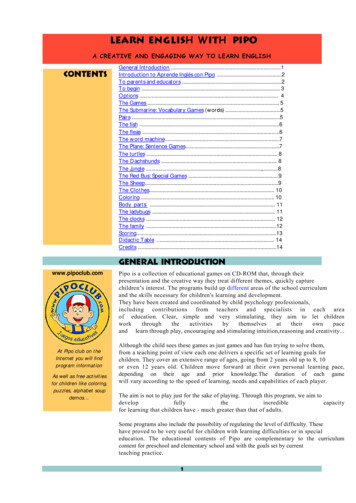
Transcription
Alearn englisH WitH PIPOAPRENDE INGLÉ PIPOCREATIVE AND ENGAGING WAY TO LEARN ENGLISHcontentsGeneral Introduction .1Introduction to Aprende Inglés con Pipo .2To parents and educators .2To begin . 3Options . 4The Games . 5The Submarine: Vocabulary Games (words) .5Pairs .5The fish .6The fleas .6The word machine.7The Plane: Sentence Games.7The turtles . 8The Dachshunds . 8The Jungle .,,.8The Red Bus: Special Games .9The Sheep.9The Clothes. 10Coloring . 10Body parts . 11The ladybugs . 11The clocks . 12The family .12Scoring.13Didactic Table . 14Credits .14general introductionwww.pipoclub.comAt Pipo club on theInternet you will findprogram informationAs well as free activitiesfor children like coloring,puzzles, alphabet soupdemos Pipo is a collection of educational games on CD-ROM that, through theirpresentation and the creative way they treat different themes, quickly capturechildren’s interest. The programs build up different areas of the school curriculumand the skills necessary for children's learning and development.They have been created and coordinated by child psychology professionals,including contributions from teachers and specialists in each areaof education. Clear, simple and very stimulating, they aim to let rownpaceand learn through play, encouraging and stimulating intuition,reasoning and creativity.Although the child sees these games as just games and has fun trying to solve them,from a teaching point of view each one delivers a specific set of learning goals forchildren. They cover an extensive range of ages, going from 2 years old up to 8, 10or even 12 years old. Children move forward at their own personal learning pace,depending on their age and prior knowledge.The duration of each gamewill vary according to the speed of learning, needs and capabilities of each player.The aim is not to play just for the sake of playing. Through this program, we aim todevelopfullytheincrediblecapacityfor learning that children have - much greater than that of adults.Some programs also include the possibility of regulating the level of difficulty. Thesehave proved to be very useful for children with learning difficulties or in specialeducation. The educational contents of Pipo are complementary to the curriculumcontent for preschool and elementary school and with the goals set by currentteaching practice.1
Aprende inglés con pipoAprende Inglés con Pipo is primarily for children 3 to 10 years old, none-the-lessmore important than age is previous English knowledge for this program can build onEnglish previously learned by the child.The main areas covered are: basic vocabulary - more than 25 themes- sentences andEnglish grammatical structures, most current expressions- body parts, time to thehour, colors In the same way the first language is learned in Aprende Inglés con Pipo,the child does not need to be reading to learn English. Con Pipo willstimulate auditory learning supported by appropriate visual images.Being aware that accents and pronunciation are very important when learning alanguage, the ability to record, phrases and words, comparing them to a model,thereby learning diction, has been made available. You can access this screen fromvirtually every game by clicking on the microphone icon.This program is structured in three blocks:1.Vocabulary games: the submarine2. Sentence games: the airplane3. Special games: the bus.The stimulating games quickly capture the child's attention, even though the activity maybe at a higher developmental level. Children will find a way to move through the game andwill eventually internalize the skills and concepts focused in the activity.The duration of each game will vary according to the speed of learning, needs andcapabilities of each player. In addition some games have several levels of difficulty.There are no time limits and the game can be exited at any time.HELPClick F1 key for help incontext. For generalprogram help click onquestion mark icon.While the objective is simultaneously one of learning and fun, Pipo is designed sochildren can interact with the computer as if it were a toy. Allowing childrenopportunities to explore, investigate, and discover the options of the game will yieldhigher levels of interest, motivation and learning.Correct and incorrect responses recorded. Scoring is important because the pointsearned serve as prizes and learning is reinforced. Children are motivated to continue withthe game, and they are encouraged to surpass their own levels of learning.However, scores are not indicative of children’s self- worth or capacity for learning.Most games have several levels allowing for a variety of entry points into the game. Aschildren master skills and content they are able to move up when they are ready. Thegames all have the megaphone available if sentences need to be repeated.LevelLevelLevelLevel1 conceptpra ctice2 s e n t e n c e w i l l n o t r e p e a t i n S p a n i s h, f l a g s p r o v i d e h e l p.3 flag help nolonger available4 n o more w r i t t e n h e l p, a u d i to r y h e l p o n l yIn s ome ga mes a s diffic ulty levels in c re a se word d ifficulty a lso inc re a s es.The F1 key in all games provides access to a brief summary explanation of the game.2
Language HelpA general language help button has been made available. Playing with the "help" button activatedprovides you with help from Pipo. In this mode the youngest players can have fun and besuccessful playing and learning. Playing without "help" you hear only Cuca speaking in English.Most important is that the children get a sense of what they hearingat a very young age, while their capacity for learning is greatest.in EnglishRecommended for the young child:Coloring: Learning colors in EnglishThe Beach: Learning body parts in English.The lambs: Practice numbers in English.Dress Pipo and Cuca: Learn articles of clothing in English.PairsNormally, 3 year olds on their own initiative will not spend longer than half an hour with the computer therefore, in general it is not recommended that young children exceed that time with the games.tobeginFrom the very first screen Pipo gives you the option of going directly to "Play" or to the"Options", where you will find a summary of all the games.First time playerswrite your namehere.Write it the sameway twice.CreditsIf your name is alreadyon the list just click onit .EXITPLAYAccess help on each screen. Clicking on the green question mark will take you to generalhelp.Access to Configuration options (click at the same time keys “A” and “F8”).Access to scores.Options.RECORDINGClick on microphone torecord. For moreinformation click on help.IN LONDONClick on "Play" and first game screen appears: a London scene. From here you willaccess the different games and activities.The Bus (Specialgames).The plane(Sentencegames).Special ButtonsThe submarine(Word games).F9 ScoringF1 HelpGlossaryGrammarList of topicsSPECIAL BUTTONSWith the microphone wecan record our ownvoice, and compare it tothe original to improvediction.1.2.3.1. Microphone: To record and listen.2. More or less help in Spanish.3. The flags: Pipo and Cuca will repeat in language you choose.3
OptionsThe F5 key will access options screen.F5GlossaryGames and ActivitiesList of activitiesGrammarScores and Playerprogress record F9).ExitGLOSSARYList of ActivitiesGlossary:You will find hundreds of English words. write in Spanish the word you need to know inEnglish and Cuca will read it for you. Click on a word in the book, Pipo and Cucawill pronounce it for you.The arrows: Move youforwards or back throughthe words.If the word is in Pipo'sdictionary you will seeit here.Alphabet: Click directlyon letter you need.Write the word youwant here.List of Activities:A list of all the themes in this program. Moving the mouse over the icons will reveal thegame it represents.Here you will find thegames in each theme.Click on the themeand Pipo and Cuca willread it.ExitTo go to a game, click on a theme to see a selection of the games in that themeGRAMMARGrammar:A brief overview of English grammar. An appendix directed to older children andparents.The contentsprovides access toany sectionReturnClick here to turnpage.Green arrow:returnto home pageGAMES AND ACTIVITIESGames and Activities:A general overview of entire program.Click on these arrowsto see the differentgame screens.Brief description ofthe game on thescreen.Click here if youwant to see otherproducts in thecollection.Click on the screen toaccess the game.4
the gamesBy clicking on the submarine on the main screen(London) you will access the submarinewhere you will play vocabulary games: matched pairs, the fish, lthe fleas and the wordmachine.On the airplane you will travel to a screen where you will practice sentencesand play with: the turtles, the dachsaunds, and jungle monkeys.On the red bus you will visit the city and focus on specific content: the lambs(numbers), coloring (colors), clothes (articles of clothing), body parts, ladybugs(prepositions and adverbs), clocks and the family.vocabulary games: the submarineAccess clicking on the submarine on the London screen. there the child will practicevocabulary, learning new words and practice familiar words.Theme selection:These include areas famliar to the child, the park, the house There are a total of 20of 20 themes. Simply click on the picture or word.Click on the theme youwant.The FishCuca reads teh tital inEnglish and it appears inSpanish on the submarine.If you have activated thehelp button, Pipo will repeat in SpanishYou will see the themesappear here.Total points for vocabulary games.Click on a word and thisfish will appear to eat it.IN THE SEA:Once the child has selected a theme , he/she will practice with the jellyfish beforemoving on to the game. Click on the unfamiliar words before playing the game.THE JELLYFISHIndicate the number oftimes you have clicked on aword. After the 3rd time ahappy face jellyfish willappearThe jellyfishScore for this theme.Change theme: Button.Theme titleGamesClick on the word to seewhat happens!Special buttons(pg3).The bar at the bottom of the screen contains all the games in the theme: pairs, fish,fleas and word machine. These will change according to theme.the pairsAcademic Objectives:Match picturesHow to play?As you uncover the boxes remember where pictured object has appeared previously.If you can find the matching pair you get a point! If not the other player will get a turnto earn the point. Here you will practice and learn theme's vocabulary and strengthenmemory and concentration ability.5
SKILLSClick on two boxes to find a pair.Visual and AuditoryMicrophone: Practice EnglishpronunciationMemoryPronunciationSelect a level.Ships light-upon your turn.For each point won the shipmoves up. The winnerlaunches his/her ship firstCoordinating VocabularyVisual skillsMatching pictures to words4 difficulty levels:Sound DiscriminationLevel 1: Objects appear and names are heard in English and Spanish.Letter-sound relationshipLevel 2: No picture. Word appears written in English and Spanish.Level 3: Words appear written in English, you can ask Pipo for help.Level 4: Only audio available.the fishSKILLSVocabularyReadingWord to PicturematchingRecognizing Englishletter sound relation.Academic Objective:Increase and acquire vocabulary.Oral expression in English.Bilingual Reading/writing . HowHow to play?In this game look for the fish with the word spoken by Pipoin Spanish and corresponds with picture in the bottle.Click on the fish withcorrect word.The picture of objectneeded appears here.For more informationabout this game clickon F1.4 levels of difficulty:Level 1: For practice; Cuca helps you say the word in English.Level 2: Cuca can help if you click on the flags.Level 3: No more flag helpLevel 4: No written text; move cursor over each fish to hear the word.The fleasSKILLSVocabularyMemory ConcentrationAccent and pronunciationin EnglishMatching wordsTranslationAuditory perceptionAuditory DiscriminationAcademic Objectives:Increase and acquire vocabulary in English .Learn to write words in English and Spanish.How to play?The word in English on the tree to the right matches a Spanish word on the tree to theleft. You must join the two words.Megaphone: RepeatwordClick on flag for help.Microphone: Practiceyour pronunciation.Choose capitol or lowercase4 difficulty Levels:Level 1: Practice.6
Level 2: find the pair by yourself, but if you need help click on the flag and Pipowill give you the answerLevel 3: No flag help.Level 4: Only audio support. No written help. Move over each word and Cucawill tell you the word.WORD MACHINESKILLSVocabularyAuditory perceptionReading EnglishwordsAccent andpronunciationLetter soundrelationshipAcademic Objectives:Increase and enrich vocabulary.How to play?These machines conceal many objects. Find the one Cuca is asking you to find inEnglish.Practice the pronunciationat any time.Click on the picturematching Cuca's requestin English.I f you are wrong, Pipowill say the word inSpanish.Relate Picture to word4 levels of difficulty:Level 1: Practice, Pipo will help you in Spanish.Level 2: Get help by clicking on the Flag.Level 3: No flag help.Level 4: No written help. Exercise in auditory discrimination and perception.Sentence games: the airplaneFrom the London screen click on the plane to access this block of games. In this section thechild will learn many household phrases in English. While learning basic grammatical structuresin English.Selection of theme: You can choose a theme from among 9 available. You will then find specificphrases in each theme.Click here for this theme:In the bathroom.Translation of themeinto Spanish.Player's name.THE HELIUM BALLOONSIndicate how many times youhave clicked on a word. Afterthe third time a balloon withPipo's face appears.THEMESELECTION:Theevening:Selecta themeamong availablewillencounterspecificsentenceseach theme.Firstyoupracticefromthe phrasesby clicking9.onYoueachone. Then go tothe gamesto use inthemwhile playing.If you click on the Radio button, the reading in English and Spanish beginsimmediately.Title of chosen themeSpecial buttons (pg 3):The plane has totalpoints tally.Microphone: Practicepronunciation.The balloons tell youhow many times youhave clicked on theword.Change themebuttonFlags: When you needhelp.Radio: Activatesreading.7GamesWith more or less helpin Spanish.
the turtlesSKILLSVocabularyEnglish GrammarAccent and pronunciationWord relationshipsSequencingAcademic Objectives:This game helps you with English syntax.How to play ?Help the turtles complete the sentence.Click on the word anddrag to it's place in thesentence.Reading/Writing EnglishMegaphone: repeat thesentenceLetter-sound relationSelect level.Now it is your turn,click on themicrophone and listento yourself in English .Flag Button3 levels of difficulty:Level 1: Practice. The sentence appears in gray and you must move words to thesentence.Level 2: You have a model but it is on the bottom of the screen.Level 3: No model. Put the words in order without the written modelThe dachshundsSKILLSReadingVocabularyEnglish expression andpronunciationAuditory DiscriminationAuditory MemoryAcademic Objectives:Practice English syntax, pronunciation,and expression.How to play?Find the sentence in English that matches what Pipo is saying.en castellano.As you move over thedog it will read you thesentence.Click on the dog matchingwhat Pipo is saying.Practice the sentence.Levels Button.2 levels of difficulty:Level 1:Written text help (You can see the sentence on the dog).Level 2: Move the cursor over the dog to hear the sentence; no written help, Pipowill help if you are incorrect.The jungleSKILLSEnglish/Spanish ReadingPronunciation/accentAuditory DiscriminationAuditory MemorySentence matchingAcademic ObjectivesEnglish/Spanish reading.Familiarization with household phrases.Learn grammatical structures in both languages. Howto play?Find the sentence in Spanish that Cuca says in English.This is just like the dog game but in reverse. You continue practicing the grammatical structures in both languages.Comprehension8
When you move thecursor over the phrasePipo reads it to you.Microphone: RepeatsentenceMicro: To practicepronunciation in English.If incorrect Cuca willread it in English.2 Levels of difficulty:Level 1: At the bottom of the screen you will find the sentence in English to bematched with the corresponding sentence in Spanish.Level 2: No written support. You will have to listen carefully to Cuca read in English.special games: The red busFrom the London screen,click on the red bus, to access the special ellingtime,learningnumbers, prepositions, family relationships, etc. They are all fun, begin withthe one you like the most! Click on the bus window to go to the game of your choice.The lambs: Cucacounts lambs beforegoing to sleep, do youwant to count withher?Body Parts:Playing on the beachyou will learn thebody parts.Color: Learn colorsin EnglishLadybugs::to learn Englishadverbs andprepositions.Clocks: .Can you telltime? Now youwill learn!Clothing: Cloth Pipoand his sister Cuca.¡You can give themsunglasses!Family: They areall Pipo's familybut. Which one ishis uncle?the sheepSKILLSHand-eye CoordinationVisual PerceptionNumber-symbol relationAuditory and NumericDiscriminationAcademic Objectives:Learn number sequence orally and written form in English.How to play?Cuca always counts sheep when she can't sleep, in Spanish?, No, in English, youwill have to figure out the number Cuca is counting.Look for the lambwith the number ofCuca's count.Microphone repeatscount.Changes difficultylevel.6 Levels of difficulty:Level 1:Practice. Number you are seeking is written at bottom of screen.Level 2: No written number. Work only with first ten numbers.Level 3: Work with 10 to 20Level 4: Work with 20 to 399
Level 5: Work with numbers to 99.Level 6: Work with 3 digit numbers.clothesSKILLSEnglish readingPronunciationRelate clothing name towearing apparelDress CucaClick on photo to changecharacter to be dressed(Pipo or Cuca).Academic Objectives:Recognize different articles of clothing: girl and boy.Enrich English vocabulary.Place clothing on place where it belongs.How to play?In this game you must dress Pipo and Cuca appropriately with clothing appearingin the closet. You can only use a clothing type once. There are two playingmodes"Creative Mode:Dress the characters according to your taste in clothes.Solving Mode: Dress characters as directed.If you are wrongput the clothes inthe laundry basket.If you want to dress agirl click on Cuca'sphotoChange difficultylevel.The eraser eliminates all the clothesChange game mode.Flag button.4 Levels of difficulty:Level 1: Cuca speaks in English, Pipo translates to Spanish.Level 2: Only Cuca speaks as usual in English, but by clicking on the flag, Pipo willhelp you in Spanish'sLevel 3: No more flag help.Level 4: No written words: Listen carefully to Cuca 's directions.coloringSKILLSMatch colors to writtennameHand-eye CoordinationAuditory DiscriminationAcademic Objective:A fun way to learn the color names in English.How to play?Color the picture with the brush. Dip the brush into a color and pass over area to becolored in that shade.Fine and Gross Motor SkillsNote: Color for this zoneis here.Microphone: To practiceEnglish pronunciation.MemorizationTo clear all the picture.The arrows:take you toanother picture to becolored.Change the levelExit.3 Levels of difficulty:Level 1: For the youngest players. Learn color names in English. Cuca tells you thecolor names as you use the color on the picture.Level 2: The picture is divided into specific color zones and color is written in thezone. Player color corresponding to written color to complete each zone.Level 3: Written colors in zones disappear. Click on a zone and Cuca will tell youthe color you need for that zone (in English).10
body partsSKILLSHand-eye CoordinationVocabularyPronunciationAuditory PerceptionAcademic Objectives:Enrich English vocabulary, written and spoken, while learning body parts.How to play?Learn body parts while at the beach. Click on the body part Pipo and Cuca indicate.You can change Pipo's body focus (front, back or the face) by clicking on thecubes at the bottom of the screen.MemoryMatch words topronunciationRecognize body partsCubes : to change Pipo'sposition.This is the word you needto find.Change level.Megaphone: RepeatsquestionFlag button: Repeat inlanguage you choose.4 Levels of difficulty:Level 1: To practice. Cuca identifies a body part in English and Pipo repeats it inSpanishLevel 2: Body parts to be identified are more difficult. Only Cuca identifies inEnglish, but you can use flag button.Level 3: No flag help therefore no translation possible.Level 4: No written help. Audio only.THE CLOCKSSKILLSNumerical SequencingAcademic Objective:Learn to tell time in English.How to play?Select the clock displaying the correct time.Telling timeHere you can seetally of correct and incorrectresponses.Find the clock with the hourCuca needs.Ask Pipo for help here.Reading time using positionMicrophone button:of clock handsLevels button6 Levels of difficulty:Level 1: Time on the hour.You can ask for help.Level 2: Time “half”hour and “quarter” till the hour. You can ask for help.Level 3: “Quarter after”and “half”hour, “quarter”till. You can ask for help.Level 4: No help at all. Minutes introduced: " 10", " 15", " 20" Level 5: No help. Minutes after the hour introduced: “ 15 after”, “20 after” “ 25after”.Level 6: No help. All time concepts previously identified11
the familySKILLSLearn family c Objectives:Learn family relationships.Increase English vocabulary.How to play?This is Pipo and Cuca's family: parents, grandparents, cousins With them you willlearn about family relationships. Study the photos carefully to learn who is who.Find the photo of the person Pipo and Cuca want you to find.Auditory perceptionMatch pictures to wordsTally of correct andincorrect choices.Microphone button:Practice pronunciationS elect level.If you need help clickhere.Exit.After level 36 Levels of difficulty:Level 1:Practice; Pipo repeats in Spanish and Cuca speaks in English.Level 2: Only English. Flag help if needed.Level3: More difficult relationships appear nephew, uncle, wife, husband.Family tree appears after this level. The person's photo lights up if they are thefocus.Level 4: More new terms: father-in-law, brother-in-law Level 5: Nothing written, still have flag help.Level 6: Includes all previous content with no ionAcademic Objective:Learn most common adverbs and prepositions.How to play?Find the ladybug Pipo an Cuca are looking for.Oral ExpressionIf you do not understandclick on the flags.Discriminatesituation in contextAuditory Perception4 Levels of difficulty:Level 1:Practice. The word or sentence appears in English and Spanish.Level 2: Cuca speaks only English, but Pipo can help if you click on the flags.Level 3: No Flag help.Level4: Practice with oral English. No more written help.12
scoringF9F9Pulsandosobrela teclaF9 seClicking on theF9 keyaccedealapantalladetakes you to the scoringpuntuaciones.section.The program can track and monitor scores for up to 99 players, this feature can keepchildren engaged and motivated.Progress is recorded according to levels and scores in all games attempted by eachplayer.General scoring screen:To find scores for a specific game, select the section where the game is found: theSentence games (airplane),Special games (red bus) or Vocabulary (submarine).Total scores only forJuegos de Frases.Total scores for allgames.Score for all Juegos deVocabulario.Cumulative score for allthe Juegos Especiales.Name of player.Scoring for Juegos del AviónThese are the scores for the Frases section. You can see the scores for each themeby clicking on the text.Click on the bar to directlyaccess the game.Move the cursor over thescore bars and a briefexplanation of the gamewill appear.Scores for each game.Exit.Scores for each theme.Total scores.Scoring for Juegos del Autobústhese scores are for all games in Juegos Especialessection.Click on the bar to directlyaccess the game.Move the cursor overthe score bars and abrief explanation ofthe game will appear.Scores for each game.Total scores.Scoring for Juegos del SubmarinoThese are the scores for the Vocabulario section. You can see the scores for eachtheme by clicking on the text.Click on the bar to directly access the game.List of all themesScores for each themeTotal scores.Scores for each game.Exit13
TABLA DIDÁCTICAPAREJASPECESPULGASMÁQUINA DE LASPALABRASTORTUGASJUEGOSPERROSSALCHICHASELVA- MONOSOVEJITASROPACOLOREARPARTES DELCUERPORELOJESFAMILIAMARIQUITAScreditsCopyright 1996-06.Cibal Multimedia.Total and/or partialreproduction, adaptation,or translation withoutprior permission in writing is forbidden, exceptwhere permitted by thelaws of author copyrights.Legal deposit:PM 1499-2006.ISBN 84 95370-33-6.All rights reserved.http://www.pipoclub.comProduced by: CIBAL Multimedia S.L.Original idea and direction: Fernando DarderOriginal graphical creation: Eva BarcelóMelodies: Pedro DarderGraphical design, illustration and animation: Eva Barceló, JavierLiébana,Miquel AlbertíPipo’s voice Spanish: Aina CortésCuca’s voice English: Frances McMahonProgramming: Fernando Darder, Miguel Ángel Ferri, Marc Puig, AliciaGonzález,Juan Gabriel CovasSound technician: Pedro Darder, Miguel Ángel Ferri, Marc PuigPsychopedagogical consultant: Fernando Darder, Mónica PablosContents revision: Catherine CobbContents learning guide: Mónica PablosEnglish translation: Lesley Ann DanielsCommercial direction: Domingo SanzCommercial department and management: Pilar Gómez, Domingo SanzCollaborators: Carlos Darder, Aina Darder, Toni Darder, Pilar CIÓNPALABRA Y/OIMAGENASOCIACIÓNGRAFÍA-SONIDOPERCEPCIÓN VIAUALY/O AUDITIVACOORDINACIÓNVISOMOTRIZVOCABULARIOLECTURA Y/OPRONUNCIACIÓNMEMORIA VISUALY/O AUDITIVAHABILIDADES
In the same way the first language is learned in Aprende Inglés con Pipo, the child does not need to be reading to learn English. Con Pipo will stimulate auditory learning supported by appropriate visual images. Being aware that accents and pronunciation are very important when learning a language, the ability to record, phrases and words .
